Has something been eating your orchid? Perhaps your orchid has been invaded by gastropods. Learning how to get rid of gastropods can be an easy process.
Gastropods, or more commonly known as snails or slugs, can cause extreme damage and harm to your orchid plants. It is important that you address this problem right away and take necessary actions to get rid of any gastropods that may be feeding off of your orchid.
If you suspect something is harming your orchid and you notice holes throughout the leaves, it is important that you are able to identify and treat the problem. Knowing whether or not your orchid is being infested with gastropods is essential to the health of your plant.
Throughout this blog post you will learn orchid pest care for gastropods including:
- What gastropods are
- Different species of orchid gastropods
- Treatments for gastropod species and ways to get rid of them
- Common species of orchids gastropods eats
- Signs gastropods are feeding on your orchid
- How to prevent gastropods
By the end of this blog post, you will be an expert on identifying and treating pest problems like those caused by gastropods and preventing these pests from invading your orchid again.
FTC Disclosure: This website contains affiliate links. If you choose to purchase any items, EverythingOrchid will receive a commission at no additional cost to you.
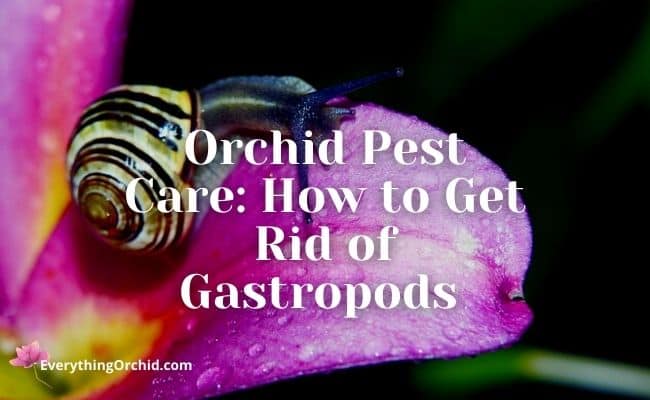
Table of Contents
What are Gastropods?
Gastropods (also known as a snail or slug) are a common orchid pests that may be invading and feeding on your plant.
This type of pest belongs to a large class of invertebrates. Snails and slugs belong to the Gastropoda family of invertebrates. There are over a thousand different species of gastropods in the world. Gastropods can vary in size and color, while almost all snails have shells.
Snails and slugs are native to almost all regions in the world (near lakes, rives, ponds, oceans, fields, greenhouses, your own backyard, and much more). This causes any plant you may have outdoors to be at risk of gastropod exposure.
Snails and slugs (gastropods) can be found both on indoor and outdoor plants. Pests like gastropods can be introduced to indoor orchids and household plants if exposed to a new plant brought from the outdoors or greenhouses.
Your new plant may already have snails or slugs on them, or may contain eggs from these species. It is always important to check any new plant you may be exposing your existing ones to.
If you don’t check your orchid for these pests, then gastropods can rapidly multiply and infest your other plants.
Gastropod Eating Habits
This pest likes to feed on many different plants, with orchids being one of their favorites. Snails and slugs will eat any part of your orchid plant. These pests love to eat leaves, roots, stems, and even blooms.
Besides having half eaten plants, you can tell if a gastropod has been eating your orchid because most species will leave a slime or webbing on your plant.
Gastropods typically only come out of hiding and eat at night or the early mornings. These are the best time to check your plant for any gastropod infestations.
Gastropod Life Cycle
Most species of gastropods are hermaphroditic, meaning all snails and slugs have both male and female sex organs. They can reproduce without the intervention of another gastropod. Being hermaphroditic allows these pests to be able to rapidly reproduce at anytime. Gastropods will inhabit potting and soil mediums, where they will also lay eggs.
There are two stages in the life cycle of gastropods. The first stage is the immature stage, while the second stage is the adult stage.
Adult gastropods will lay up to 300 eggs, therefore it is essential that you quickly get rid of this pest once identified. If you don’t treat your orchid or other household plants, then gastropods can quickly expand in numbers and go on to harvest and destroy you plants.
The average lifespan for gastropods is about 2 years. These pests begin their life as an egg. Once the egg hatches, the gastropods enter the immature stage in the life cycle.
During the immature stage the gastropod spends most of its time feeding on plants. The immature stage only lasts one year. Immature gastropods look the same as adult gastropods, only they are smaller in size and their shells are more vibrant in color.
There is little difference between the immature and adult life stages for gastropods. One of the biggest differences is that during the adult stage gastropods are able to reproduce and lay eggs. The adults also tend to be larger in size.
Adult gastropods, like immature ones, spend their days devouring plants. The adult stage in the life cycle of a gastropod only lasts a year.
Different Species of Orchid Gastropods
There are several species of gastropods that favor orchids over all other plants. It is important that you know these specific species so you can easily identify these pests and learn proper ways to get rid of them.
Common species of orchid gastropods include the:
- Bush snails
- Brown garden snail
- Gray field slugs
- Marsh slugs
How to get rid of Gastropods: Bush Snail
Bush snails are a common pest that feed on orchids. The scientific name for this type of snail is the Fruticicola fruticum. This is the only known species of a bush snail. Fruticicola fruticum belong to the Helicoidea class of snails and slugs.
The bush snails are native to central and eastern Asia and hav spread to various regions of the world, most commonly in Europe. You can normally find bush snails living in in forests and even your backyard bushes. Bush snails prefer warm, humid, and moist environments. The snail can be found hiding and living under rocks, wet plants, and wet piles of leaves.
This specific species of snail only comes out at night. This is when the snail will feed on your orchid and other plants. Nighttime is the best time to check for bush snails and exterminate them.
Fruticicola fruticums are herbivores, meaning they only eat plants. They favor orchids over most other plants, but will eat any plant that is available to them.
How to Identify Bush Snails
It is easy to identify bush snails. Most bush snails are tan or grey and can vary in body size (usually between 10 to 25mm in length). The easiest way to identify this type of snail is based on its shell.
The shells normally vary in size and are proportionate to the bush snail’s body size. Shells are normally thin and has wavy spirals throughout the shell. The shells can vary in color and are normally light brown, grey, and may even have purple and yellow hues throughout it.
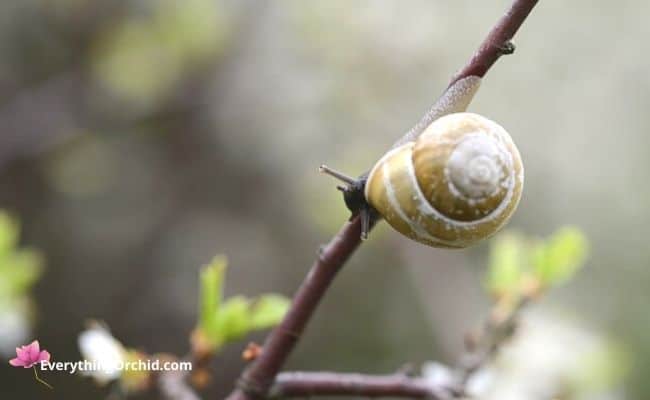
Treatments for Orchids to get rid of Gastropods: Bush Snails
The only time you will ever notice a bush snail on your orchid is at nighttime. This is when the snail leaves the potting medium and feasts on all parts of your orchid. You may be in shock one morning when you wake up and notice that something has begun eating your plant.
Therefore if you notice this pest coming out at night or notice something is indeed eating your orchid, you should immediately treat your plant for this pest.
There are several natural ways you can treat your orchid and get rid of the pesty bush snail. I suggest trying the natural and organic treatment methods first, before trying any solutions or mixtures that you can buy in stores (they will usually help with your snail problem but harm your orchid in the long run).
Natural and organic bush snail treatments include:
- Treating your orchid with caffeinated products
- Giving your orchid beer
If you try the ways listed above to kill the bush snails and see no results, the you should resort to giving your orchid Metaldehyde, Iron Phosphate, Copper Tape, or Diatomaeous Earth. But beware, these products may get rid of your snail problem, but will cause extensive damage to your orchid.
Using Caffeine to Kill Bush Snails
You can use caffeinated products such as coffee or tea and mix them with water (the ratio should be half coffee/tea, half water). You should also add a teaspoon of rubbing alcohol with your mixture. Place your caffeine mixture in a spray bottle, and spray your orchid and any visible bush snails.
You should repeat this process twice daily for one week.
Using Beer to Kill Bush Snails
Another effective and harmless method you can use for bush snail treatments is by giving your orchid beer! Yes, you read that right. Bush snails are attracted to the smell of beer.
You can use any type of beer that you may have (I recommend using the cheapest one you got!). All you need to do is place the beer in a small bowl or dish and the scent will draw the bush snails out. If the snail consumes the beer, it will eventually kill them.
How to get rid of Gastropods: Brown Garden Snail
Brown garden snails are another invasive species that likes you prey upon orchids and many other plants. This species of snail, scientifically known as Cornu aspersum, is native to various regions throughout Europe (like Britain, the Mediterranean, and the Black Sea. Today, the brown garden snail has become an invasive species known worldwide.
Cornu aspersum (brown garden snails) like cool, dark, and wet environments. This species of gastropod best survive in climates that are 40 to 60 degrees Fahrenheit and wet. Though brown garden snails can survive environments that reach 23 degrees Fahrenheit.
You can normally find this snail living in forests, along rivers, lakes, under rocks, in wet soil, or in your own yard. They may even be inhabiting your orchid.
The brown garden snail will usually burrow itself in your orchid’s potting medium. This is where they will lay their clusters of eggs and can form massive colonies. Like the bush snail, the brown garden snail will only come out and feed on orchids and other vegetation at night or in the early mornings.
If you want to see these pests for yourself it is best to check your plant at night.
How to Identify Brown Garden Snails
It is important to be able to identify a brown garden snail is you suspect something is eating your orchid.
This species of snail is known for their large, brown shells. The shell is horn shaped and normally has 4 to 5 spirals throughout (with many fine lines and wrinkles throughout it) and can grow to be 28 to 32 mm in size. Their shells are brown, with various shades of yellow, white, and dark brown throughout it.
The bodies of a brown garden snail are normally a brown-grey color and are slimy and covered with mucus. The bodies are protected by the hard shells, where the snail will retreat when it feels threatened.
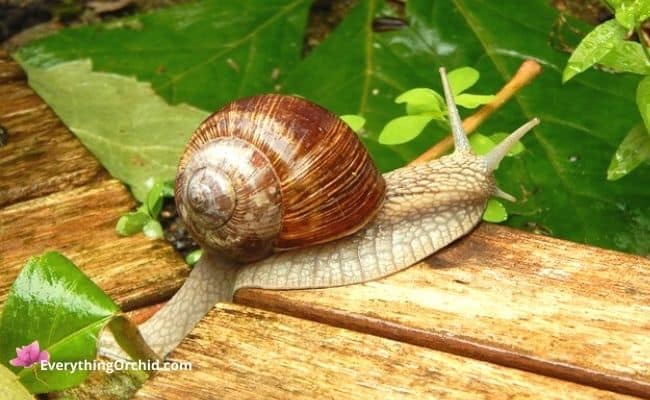
Treatments for Orchids to get rid of Gastropods: Brown Garden Snail
There are several different treatment methods you can use on your orchid if you suspect your plant has been invaded by this pest. Similar to the bush snail, you can use organic treatments like beer and caffeine to draw out and kill the brown garden snail.
Other methods you can use to get rid of the brown garden snail include:
- Removing the snail by hand
- Apply garlic to your orchid
- Apply copper wire around your orchid
Using your Hand to Remove Brown Garden Snails From Orchids
One of the most natural and harmless way to remove brown garden snails from your orchid is by hand. No chemicals or pesticides involved, meaning you won’t harm your orchid.
But removing a brown garden snail by hand can be risky.
Most snails, including the brown garden snail, live in potting mediums during the day and can even lay clusters of 300 eggs in the soil. It may be hard to remove all traces of this pest if you rely on just using your hand.
Since this pest only comes out at night or during the early mornings, it can be hard to completely remove all snails, especially if you do so during the day.
Some of the snails may be hiding in the soil and can continue to wreck havoc on your orchid when you aren’t looking. It is also impossible to remove all eggs by hand, as you can’t visibly see them.
Snails also discharge a mucus that can carry bacterial infections. If your hand is exposed to the mucus, you risk forming an infection. To avoid this, you should always wear gloves when handling snails or slugs by hand.
Using Garlic to Kill Brown Garden Snails
Garlic consumption may be beneficial to humans, but is extremely harmful and deadly to brown garden snails. Using garlic is a perfect, natural remedy you can use to rid your orchid or other plants of this type of garden snails.
If you choose to use garlic to treat your orchid for this pest problem, you should mix a garlic clove with mineral oil and place it in a spray bottle. Let the mixture sit for 24 hours and then spray your orchid’s soil.
Exposure to garlic will cause the brown garden snail to excrete large amounts of mucus, causing it to eventually become dehydrated and dry. This will cause the snail to die.
You can also mix minced garlic with water if you don’t have mineral oil available. After mixing the minced garlic with the water you should place it in a spray bottle and spray your orchid’s soil. It will have the same effect on the snail as garlic cloves and mineral oil.
For more information on how to get rid of snails and slugs with garlic, check out Garlic Spray for Slugs.
Using Copper Wiring to get rid of Brown Garden Snails
Copper wiring acts as a snail and slug repellent. You can using this type of wiring to get rid of brown garden snails.
To treat your orchid with copper wiring, you should stream pieces of wire along the orchid stem and leaves and around the circumference of the pot. This will repel the snail and cause them to leave the plant.
But this means they will move on to the nearest plant or vegetation. If you see this snail slugging around, you should immediately remove it from the areas your plants may be in.
How to get rid of Gastropods: Gray Field Slug
Field slugs are among another species of gastropod that can be harmful to your orchid and other plants. Gray field slug, scientifically known as Deroceras reticulatum, are native to Europe and North Africa. This species has become invasive to many regions throughout the world and wreck havoc on all kinds of vegetation.
Unlike brown garden snails and bush snails, the gray field slug prefers to inhabit cultivated areas, dry areas (such as field crops, gardens, parks, fields, and grassy areas). The gray field slug likes to hide under rocks and litter.
This species of field slug only appears at night. During this time the slug will eat different plants. Gray field slugs particularly enjoy leaves and you may notice your leaves are being devoured by this species of slug.
How to Identify Gray Field Slugs
The most common characteristics you can look for when trying to identify a gray field slug is based off the color of the slug, the markings on the slug, and the mucus that this slug releases.
Deroceras reticulatum (aka gray field slugs) can grow to be anywhere from 40 to 60 mm in length.
Gray field slugs are usually a light brown or gray color. What makes these slugs unique are the different markings found throughout its body. Various dark or black markings and spots can be found on this slug, which will form a reticulate pattern.
This slug will also release mucus, which will cover its entire body. The mucus is usually colorless or can appear to be a milky-white color.
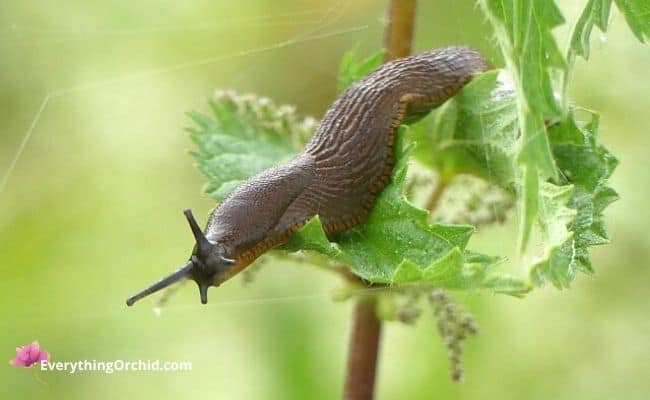
Treatments for Orchids to get rid of Gastropods: Gray Field Slug
There are several things you can do to treat your orchid for gray field slugs. You can apply previously mentioned treatments, such as using beer, your hand, copper wiring, garlic mixtures, or caffeine.
To get rid of gray field slugs you can also try:
- Using cornmeal traps
- Lure the slugs out with fruit
- Sprinkle salt on your orchid leaves
Using Cornmeal Traps to Lure out Gray Field Slugs
Cornmeal traps are a natural and harmless way to treat your orchids that may be inhabited by gray field slugs. This method isn’t always as effective as others, but is a cheap treatment for your orchid.
Some slugs will be attracted to the smell of cornmeal and will try to find their way towards it. Place a tablespoon of cornmeal in a jar, and leave it unopened and on its side overnight. By morning you should find a slug or two in the jar. Cap the jar with a lid, and dispose of it.
Get rid of Gray Field Slugs with Fruit
Gray field slugs love to eat fruit. Luring slugs out with fruit is one of the most effective and natural ways you can take to get rid of gastropods.
If you choose to use this method, try to use fruits that are rich in citrus (like grapefruits, pineapple, or oranges). The field slug will be highly attracted to the smell of the fruit.
Simply take a few pieces of whatever fruit you choose to use and place it in a jar. Leave the jar on its side near your orchid overnight and check for any slugs that may be in it in the morning. If you find any slugs, immediately cover the jar with a lid and dispose of it.
Sprinkle Salt on Orchid Leaves to Kill Gray Field Slugs
Sprinkling salt on your orchid leaves can be an effective way to kill gray field slugs. But you must take great caution if you choose to use this method.
Salt can be extremely harmful to your orchid if it reaches the soil and roots. Therefore it is important to only sprinkle the salt on the orchid leaves. Avoid roots and soil at all costs.
The salt will cause the slug to excrete large amounts of mucus, which will cause the slug to become dehydrated and die. This is a very effective treatment for killing gray field slugs or any type of gastropod.
How to get rid of Gastropods: Marsh Slug
Marsh slugs, or scientifically known as the Deroceras laeve, is native to Palearctic regions of the world. Today, this species of gastropod can be found throughout various regions of the world including Asia, Europe, North and South America.
Deroceras laeve (marsh slug) prefer humid environments and are commonly found in swamps and wetlands. Marsh slugs do have the ability to acclimate to almost any type of environment, but need consistent environmental constants in order to survive.
This species of slug are omnivores and typically feed on orchids and other vegetative plants. Like all other gastropods, marsh slugs will come out and feed at night. The rest of the day, they are hiding in the soil and potting medium.
Identifying Marsh Slugs
Marsh slugs are small in size compared to most other species of gastropods. This slug can grow to lengths anywhere from 15 to 25 mm long, making it easy to identify this species compared to other ones.
The marsh slug is usually brown to dark brown in appearance and will have clusters of light black spots found throughout its body. This type of slug has a mantle that covers over 50% of its body, making it another unique characteristic that this slug has. This slug may also have wrinkles on its skin.
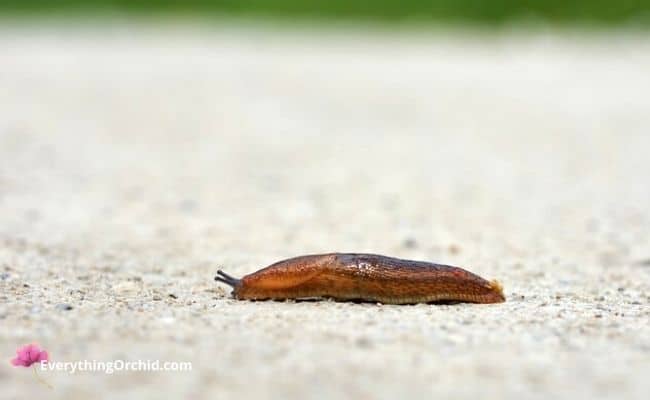
Treatments to get rid of Gastropods: Marsh Slugs
You can use various treatments to get rid of gastropods, including the marsh slug.
Treatments such as using:
- salt and garlic treatments
- removing the slug by hand
- applying copper wire throughout you orchid
- using beer, caffeine, fruit or cornmeal to lure the slugs out
which can all be effective treatments for getting rid of marsh slugs.
Orchid Species Gastropods Eat
The majority of gastropods found throughout the world will eat almost any type of plant. But orchids happen to be one of the most favorite types of plants for gastropods to feed on.
Gastropods will eat any type of orchid.
Orchids provide favorable conditions for most species of gastropods. Orchids survive in moist, humid, and warm environments, making then them perfect plant for snails and slugs to invade, reproduce in, and eat.
Signs Gastropods are Feeding on Your Orchid
There are several signs that will indicate gastropods are feeding on your orchid.
The biggest sign is holes that may begin appearing throughout your orchids leaves. There may also be chew marks along the edge of the leaf, or the leaf may be completely gone.
Gastropods also love to eat orchid roots. Roots are full of nutrients and water, making them a tasty snack for most gastropods. Parts of the root may begin to disappear and look chewed. If the gastropods begin eating your roots, then this can severely damage your orchid.
Roots are essential for air and water flow throughout the orchid. Orchids have aerial plants, which means they need to be able to absorb good air and water to survive.
You may also notice that your blooms are disappearing or have holes or chew marks throughout it. This may indicate that gastropods are feasting on your orchid.
The majority of gastropods also release mucus. Trails of clear or white mucus may be found throughout your orchid, indicating that a gastropod may be living and preying on your orchid.
Some species of gastropods also release a web-like substance. You may find webs all throughout your orchid, indicating that a gastropod may have invaded.
Gastropods can go on to cause extensive damage to your orchid, and in time, these pests may even kill your orchid. It is important to take action and get rid of gastropods as soon as you notice any signs of their presence.
How to Prevent Future Gastropod Invasions
There are several precautions you can take to prevent future gastropod invasions. After you clear of this pest invasion, it is important that you take all measures to prevent this pest from reappearing.
One thing you can do to prevent more gastropods from invading your orchid is by wrapping copper wire throughout your orchid. You should place pieces of copper wire along the stem, leaves, and base of the soil.
You should also avoid exposing your orchid to any outdoor or greenhouse plants. This is usually the biggest cause for gastropods invading indoor plants.
If you bring a new plant into your house, you should also inspect the plant for gastropods and other pests to avoid orchid infestations.
You can also spray your orchid with garlic spray mixtures weekly to prevent more gastropods from appearing.
How to Get Rid of Gastropods: Summarized
Gastropods can be extremely harmful and deadly to your orchids. It is important that you take necessary measures to get rid of gastropods as soon as you notice any signs of their presence.
Gastropods are more commonly known as snails and slugs. These species can be found throughout almost all regions of the world, including right in your own backyard.
Types of Orchid Gastropods
Snails and slugs are normally omnivores and favor most kinds of vegetation, especially orchids.
There are several species of gastropods that tend to be problematic for orchids, including the:
- Bush snail
- Brown garden snail
- Gray field slugs
- Marsh slugs
These species of gastropods normally hide in the soil and potting medium of your orchid and other household plants. They will only come out at night or in the early mornings and this is the time when they will fest on your orchid.
Gastropods will eat and inhabit any type of orchid.
Know the Signs so you can get rid of Gastropods
Signs that your orchid has been invaded by a gastropod include:
- Holes in your leaves or blooms
- Chew marks along the edge of leaves, roots, or blooms
- Disappearing parts of your orchid
- Mucus trails along your orchid
- Webs on your orchid
Use Proper Treatments to get rid of Gastropods
If you notice any of these signs, then you need to take quick action to get rid of gastropods that may be inhabiting and eating your orchid.
Different treatments you can use for almost all types of gastropods includes:
- Sprinkling orchid leaves with salt
- Removing snails and slugs by hand
- Luring the gastropods out with beer, fruit, and cornmeal
- Running copper wire throughout your orchid
- Use garlic sprays on the orchid’s soil
Prevent Further Gastropod Infestations
Also be sure to take measures to prevent further gastropod invasions. You should avoid exposing your indoor orchid to outdoor or greenhouse plants, inspect any new plant you bring near your orchid for pests. You can also run copper wire throughout your orchid and treat your plant with garlic spray once a week.
Hopefully by now you have learned what gastropods are and the common species that prey on orchid plants. If you notice any of these pests on your plant, immediately take action to get rid gastropods and take measures to prevent future invasions.
Thanks for reading!
